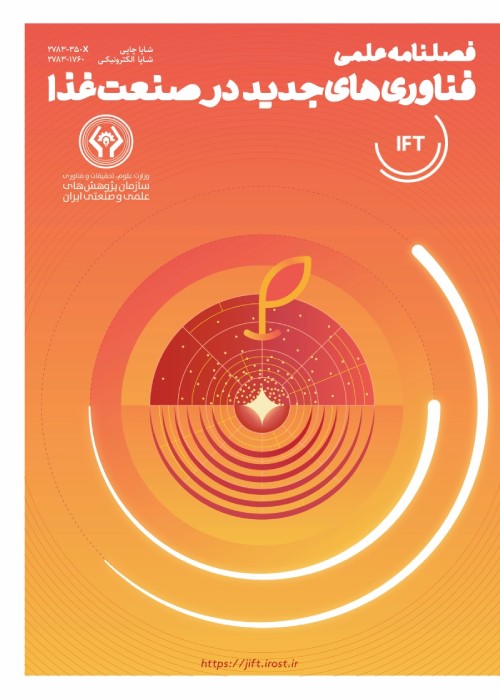Optimization of extraction and micro encapsulation of colored compounds of Urtica dioica processing waste
Author(s):
Article Type:
Research/Original Article (دارای رتبه معتبر)
Abstract:
This project was carried out to optimize the extraction and microencapsulation of color compounds of the processing waste of (Urtica dioica). Response surface method to investigate the effects of independent variables of ethanol solvent concentration (100, 50, and 0%), solvent to the raw material ratio (in three ratios of 30, 45, and 60%), three times (1, 4 and 7 hr) and Three temperatures (20, 40 and 60° C) were performed on extraction efficiency, chlorophyll content, and pheophytin of ethanolic extract of nettle color extract. Optimization of the extraction process based on the models obtained from the optimal extraction conditions, the solvent to raw material ratio was 33:67, the solvent concentration was 100%, the extraction time was 7 hours and the extraction temperature was 25°C. Under optimal conditions, the extraction efficiency was 7.99%, the amount of chlorophyll and pheophytin extracted were 54.75 and 341.54 mg/100gdry matter, respectively. In order to stabilize the extract, the microencapsulation was applied with two walls of maltodextrin and polyvinylpyrolidone by a spray dryer. Production capacity of microcapsules, moisture, bulk density, color properties, and glass transition temperature of microcapsules of Urtica dioica extract were investigated. Also, the stability of the color compounds of microcapsules during 21 days of storage in different humidity and temperature conditions was evaluated. The results showed that the microencapsulated colored compounds with maltodextrin had better physicochemical properties compared to other microcapsules. The number of color compounds in the microcapsules decreased during 21 days of storage, but the microencapsulation caused more protection and stability of the color compounds in the microcapsules in different humidity and temperature conditions. The coefficient of determination was more than 0.90) and was introduced as the optimal treatment. Both microcapsules were stable at room temperature with 121.35 and 82°C glass transfer temperatures, respectively.
Keywords:
Language:
Persian
Published:
Journal of Innovative Food Technologies, Volume:9 Issue: 4, 2022
Pages:
309 to 329
magiran.com/p2472240
دانلود و مطالعه متن این مقاله با یکی از روشهای زیر امکان پذیر است:
اشتراک شخصی
با عضویت و پرداخت آنلاین حق اشتراک یکساله به مبلغ 1,390,000ريال میتوانید 70 عنوان مطلب دانلود کنید!
اشتراک سازمانی
به کتابخانه دانشگاه یا محل کار خود پیشنهاد کنید تا اشتراک سازمانی این پایگاه را برای دسترسی نامحدود همه کاربران به متن مطالب تهیه نمایند!
توجه!
- حق عضویت دریافتی صرف حمایت از نشریات عضو و نگهداری، تکمیل و توسعه مگیران میشود.
- پرداخت حق اشتراک و دانلود مقالات اجازه بازنشر آن در سایر رسانههای چاپی و دیجیتال را به کاربر نمیدهد.
In order to view content subscription is required
Personal subscription
Subscribe magiran.com for 70 € euros via PayPal and download 70 articles during a year.
Organization subscription
Please contact us to subscribe your university or library for unlimited access!



